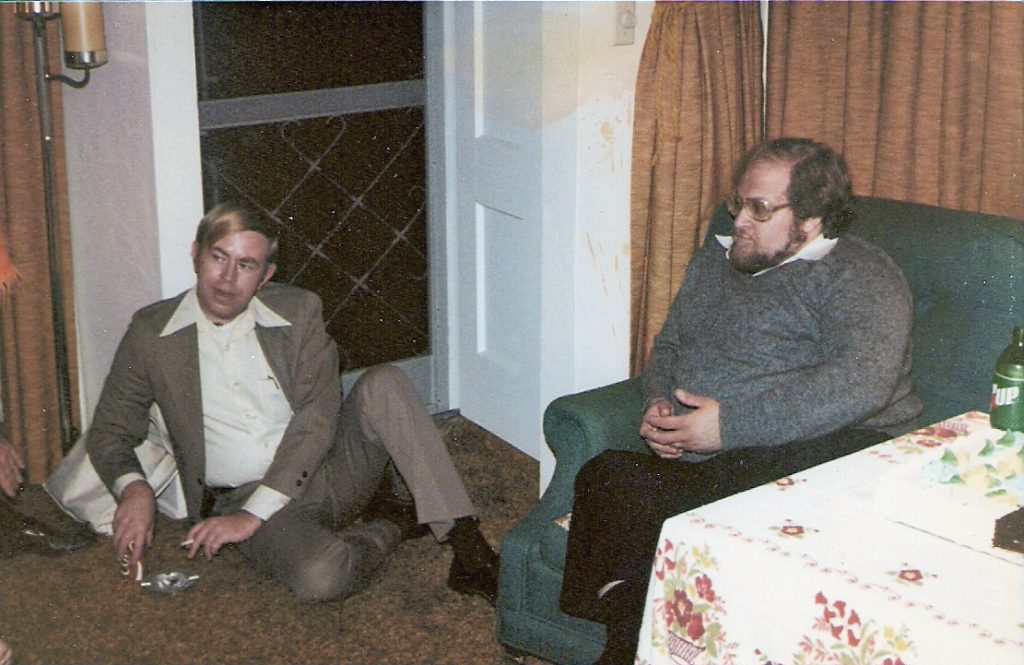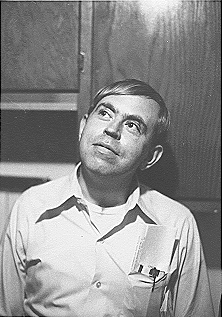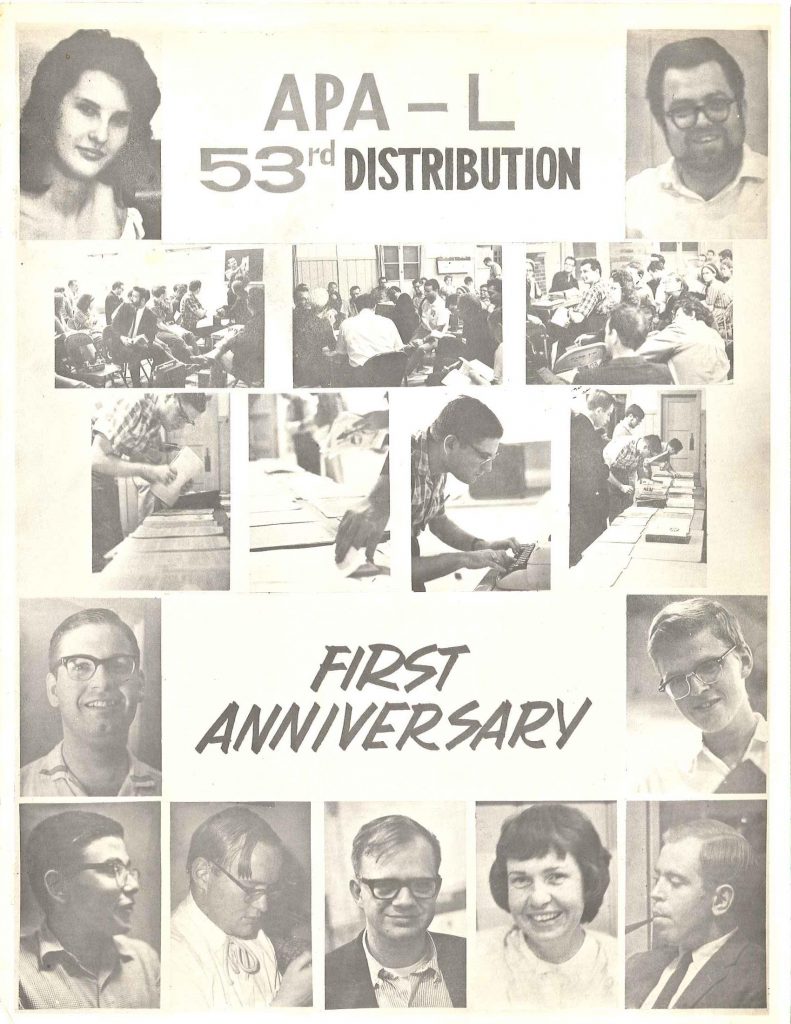By Milt Stevens: Approximately 40 people attended Corflu 34 at the Warner Center Marriott in Woodland Hills, California on April 28-30, 2017. Corflu is a convention for people who publish or used to publish fanzines on paper. Yes, paper. If you want to read more about these atavistic characters, you can go to eFanzines.com.
This is the end of the convention.
The banquet. Since most cons no longer have banquets, Corflus have them. The Corflu banquet is in the form of a Sunday brunch, and it includes such traditional items as awards, the guest of honor speech, and other business. The results of the Faan Awards have already been announced.
As you might expect, Corflus don’t handle guest of honorship the way other cons do. We feel we are all worthy of honor, so the name of the goh is picked out of a hat during opening ceremony. The goh is then obligated to give a speech at the banquet. If you really, really don’t want to be goh, you can give the chairman of the con a $20 bribe to have your name removed from the hat. Last year at Chiflu, the chairman , Nigel Rowe, forgot to give himself a bribe and ended up as goh. This year’s guest of honor was Randy Byers who gave a quite well-received talk.
One of the usual items of business at Corflu is the election of the past president of Fan Writers of America (FWA). Fan Writers of America is an organization for people who are doing fan writing, or have done fan writing, or have at least thought about doing fan writing. You might wonder why we would be electing a past president rather than a current president. Well, we’re the sort who don’t like being told what to do, so we never elect a current president to tell us what to do. The past president for 2016 is Pete Young from Thailand.
Another item of business is the choice of a site for next year’s Corflu. The choice for 2018 is Toronto, Canada. In case current international stresses increase, the Toronto Committee will make arrangements to have American fans smuggled across the Canadian border in truckloads of melons.
This is the beginning of the convention.
I thought we might start the convention with opening ceremonies, but Marty Cantor said such things just weren’t done. “Whyzat?” I asked. Marty intoned “TRADITION!!!” and did a funny little dance. It’s hard to argue with a proposition like that.
So we began the con with a panel, “Remembrance of Corflus Past” with Andy Hooper, Jerry Kaufman, and Ted White. Sometimes we get a little bit confused about past, present and future. However, when we can figure out which one is the past we love to reminisce about it. Many and noisy are the sagas of Corflus past. Names like Corflu Chromium and Corflu Titanium make the blood of all trufen run sideways. Names like E Corflu Virus and Chiflu give most fans a rash.
Not long before the end of the convention.
Andy Hooper designed a diabolical trivia contest. There were two teams in the contest, the Slan Boys (Rich Coad, Jerry Kaufman, and myself), and The Winning Team (Sandra Bond, Ted White, and a third person who was a bit too far away for me to recognize.) It’s obviously hubris to name your team The Winning Team, and you know how the gods are about hubris. Of course, they lost. Also, our wildass guesses proved to be luckier than their wildass guesses.
The audience was quite amused by the totally obscure questions and the expressions of indescribable horror they produced on the faces of the panelists.
As an example of an obscure question, “In the softball game at the 1939 Worldcon, what position did Art Widner play?” Of course, we knew who Art Widner was, but fans don’t pay attention to sports. While nobody got the correct answer, Art Widner played catcher in that game.
As an example of a medium grade question, “Of the following articles, which one wasn’t written by Charles Burbee?”
(A) Al Ashley, Successful Novelist
(B) Al Ashley, Indefatigable Gardener
(C) Al Ashley, Elfin Edison
(D) Al Ashley, Galactic Observer
I knew that Al Ashley, Elfin Edison, and Al Ashley, Galactic Observer had been reprinted in A Sense of FAPA and were by Charles Burbee. That gave me a fifty-fifty chance on the other two.
Somewhat after the beginning.
Panel: “Fandom and Us” with Rob Jackson, Karl Lembke, and myself. Are we even in fandom anymore? Does it matter? What the heck is fandom? As a reactionary, I think fandom should be about reading and stuff. It’s the “and stuff” that causes the problem.
Somewhere in the middle.
I think it was nighttime. I could tell because it was dark outside. We were in the con suite. As always, Karl Lembke did a great job with the con suite. After the con, prominent Toronto fan Murray Moore reviewed the con as “The program was good, the cookies were great.” Somebody or possibly several somebodies had donated a case of various wines to the con suite. This was in addition to the homebrew and exotic beers. As the bottles became either half empty or half full, the attendees became either half sober or half inebriated. Funny how things work out that way.
Spike mentioned she was organizing the program for the next World Fantasy Convention. WFC only has two tracks of programming which is a lot more sensible than most cons. Since I’ve organized a few con programs in times past, we talked about doing programs for awhile.
Bill Burns asked me what I thought about Mr. X. I’m not quite sure what I think about Mr. X. I’m one of the few people who regularly writes letters to his fanzine, but I don’t really know anything about him.
I told Michael Dowd I thought he was the most atypical fanzine I had ever encountered. Issues of his fanzine Random Jottings are about the same size as issues of Analog. He has had one issue devoted to Watergate and another devoted to the Samaritans. Several people told me I had a letter of comment in the current issue which Michael was distributing at Corflu. That isn’t really surprising, since I think I write letters to most issues of most fanzines.
After the middle but before the end.
Auctions at Corflus are lively affairs. This year’s auction was heavy on fanzines from the Los Angeles area such as VoM and Shaggy from the forties. The most expensive single item was a hardback anthology The Best From Xero which included material from Dick and Pat Lupoff’s fanzine which sold for $55. Graham Charnock was making bids in the auction while still being in England. Graham was doing it through a laptop carried by Rob Jackson. At Graham’s requests, Rob would move the laptop around so Graham could get a better look at what he of bidding on. At the beginning of this, I described the attendance as “Approximately 40.” Graham was part of the “Approximately.” How should you count someone who is participating in the con from thousands of miles away.
After the beginning but before the middle.
Strawberries. Lots and lots of strawberries. We didn’t pick-up enough room nights, so we had to buy more stuff from the hotel to make up the difference. This took the form of strawberries and chocolate. The chocolate included brownies, and cookies, and candy. With a maximum effort from the entire membership, we were able to consume all of it burp
Probably sometime but maybe not around here.
Panel: “Beyond Numbered Fandoms” with Greg Benford, Sandra Bond, Mike Glyer, and Ted White. The idea of numbered fandoms is based on Arnold Toynbee’s conception of history in his book A Study of History. Toynbee thought a civilization was defined by the universal state and the universal church. With numbered fandoms, the universal state and the universal church are replaced with the Focal Point Fanzine. With the decline of each Focal Point Fanzine, an interregnum begins and fans retreat into the apas (amateur press associations). This model also includes a few barbarian invasions. Strangely enough, this model seemed to work for quite awhile. Then Harlan Ellison proclaimed false seventh fandon, and all fandom was engulfed in guacamole.
Efforts were made to salvage the numbered fandoms model, but they never really worked. There was muttering about a model based on dialectical fanac, but that gave everybody stomach cramps. Some suggested fan history might even be influenced by things outside of fandom such as WWII and the introduction of the hula hoop. Others suggested we might be living in a post modernist fandom where the center was marginalized, the margins were central, and rationalism was the bogey of small minds. Stay tuned for further developments.




